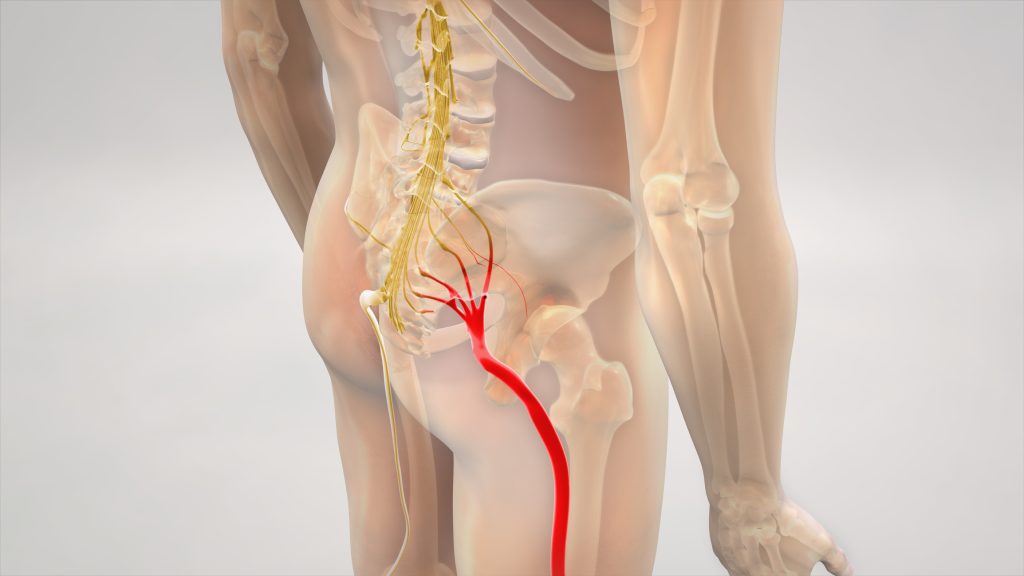Find Relief from Sciatica
Sciatica pain is a specific type of discomfort that originates in the sciatic nerve, running from the lower back down the back of each leg. Sciatica pain is often characterized by a sharp, shooting sensation that radiates along the path of the sciatic nerve, typically affecting one side of the body.
Spinal disc issues play a crucial role in the development of sciatica by directly impacting the sciatic nerve. When a disc herniates, its inner gel-like material protrudes outward and can impinge on the nerve roots that make up the sciatic nerve. Similarly, a bulging disc may press against the nerve, causing similar symptoms. The compression of the sciatic nerve by these disc issues can lead to both acute and chronic sciatica pain.
Symptoms
Sciatica pain is characterized by a distinct set of symptoms that arise from the compression or irritation of the sciatic nerve. Individuals suffering from sciatica may experience the following common symptoms:
- Radiating Pain: Sharp, shooting pain that travels from the lower back through the buttocks and down one leg.
- Lower Back Pain: Many individuals with sciatica pain experience discomfort in the lower back, where the sciatic nerve originates.
- Burning or Tingling Sensation: Sciatica can cause sensations of burning, tingling, or “pins and needles” along the nerve pathway.
- Numbness: In addition to tingling sensations, some individuals may experience numbness in the affected leg.
- Muscle Weakness: Compression of the sciatic nerve can lead to muscle weakness in the leg, particularly affecting activities such as walking, standing, or trying to lift the foot.
- Worsening Symptoms with Movement: Sciatica pain may worsen with certain movements, such as sitting for extended periods, standing up, or bending forward.
- Difficulty in Standing or Sitting: Individuals with sciatica often find it uncomfortable to sit or stand for prolonged periods due to the pressure on the sciatic nerve.
- Pain Aggravated by Sneezing or Coughing: Activities that increase intra-abdominal pressure, such as sneezing or coughing, can exacerbate sciatica pain.


Pinched Sciatic Nerve
Seeking an expert opinion?
Dr. Stidham’s diagnosis is backed by over 20 years of experience as a world class pain management specialist
How The Discseel Procedure Helps Sciatica
The Discseel Procedure stands as a beacon of hope for individuals dealing with persistent back pain. It offers a non-invasive, non-surgical alternative that focuses on addressing the root cause of the pain while promoting natural healing within the spinal discs. Here’s how the Discseel Procedure can specifically benefit those seeking relief from back pain:
- Minimally Invasive Approach: Unlike traditional surgical interventions such as spinal fusion that involve rods and screws, the Discseel Procedure is minimally invasive. It doesn’t require any hardware implantation, minimizing the risk of complications associated with invasive surgeries.
- Promotion of Natural Healing: Utilizing Fibrin, the Discseel Procedure facilitates the body’s natural healing process within the discs. Fibrin injection into the tears seals them so tissue growth can occur over time, allowing the body to restore the integrity of the discs without invasive interventions.
- Short Recovery Time: Patients undergoing the Discseel Procedure experience a shorter recovery period compared to traditional surgeries. Many can resume light activities within 24 hours and gradually increase their levels of activity as they heal.
- Patient-Centric Approach: The procedure prioritizes patient comfort and well-being. Mild sedation is offered during the procedure, and patients are able to gradually resume activities based on their individual comfort levels.
- Long-Term Relief and Healing: Most patients experience significant improvement in their symptoms within 3-6 months as the discs gradually heal. This long-term relief individuals a chance to reclaim an active and pain-free lifestyle.









































